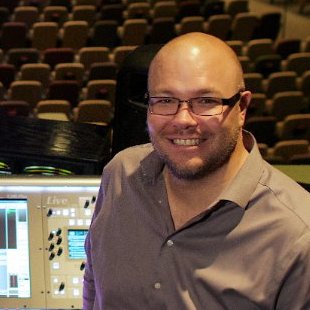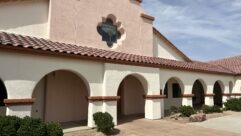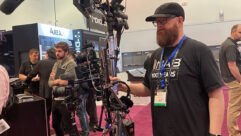

SVC: First Baptist sounds like a very big church with a long history and it seems that not all of that has been smooth sailing as far as the sound system. Did they have a number of different solutions that they were trying along the way?
Duke DeJong: The building is not quite a 100-year-old, an oversized kind of gothic-style cathedral-style building just right outside of Korea Town in downtown L.A. It’s commercial buildings and residential packed in. I can’t imagine how many people are in that neighborhood, and they’ve essentially opened this massive building up to multiple churches. It’s a beautiful, beautiful facility but with 1,500 seats, acoustics are as bad as you think they are. Nearly impossible to get up to the ceiling. The main P.A. looked like it was probably a solid 20 years old or so. It was kind of a big horn cluster. It was definitely something we haven’t seen in a while. And they had stopped using it and so instead of having somebody to come in to do it right, they started putting in a ground-stacked P.A. with a couple of speakers on sticks and a little console.
But even though it’s a large, large venue, the guys who own the building are actually not a very large church–they don’t even fill a quarter of the auditorium for their Sunday morning services. So what they’ve done is rent it out to a number of other churches through the week. Sunday afternoon there’s a Spanish church that meets in there. On Saturdays and some other times a week there’s a Korean church that meets in there. They also rent it out for movie shoots and TV shoots on occasion. And of course everybody had their own systems. So when we walked in, we see this 20-plus year old P.A. flown, but then all these ground-stacked conglomerations over on the side as well. So it was just kind of a fascinating experience to walk in there and to listen to their vision for the space, which was to just simplify all of it for various reasons—they just wanted everything cleaned up, simplified and one system that everybody could use. But with three different churches using the venue, it had to be good enough for the most rocking of the Spanish services, but also clean and very, very intelligible for the more liturgical style. It was a unique project for sure, both in the building and the needs by the client, but it turned out really well.

Sounds like there may have been a project just getting some old equipment out before the installation of the L-Acoustics system could even get started.
Well, really it wasn’t. It was all just kind of thrown up on the corners of the stages. So I mean it’s exactly what you think of when you think of a couple of smaller churches just kind of renting a venue and throwing a P.A. up, except times three. So that part was super, super simple. The part that was complicated was getting up to the ceiling. I don’t remember the exact height of the ceiling, but it was at least 50-60 feet. So putting together a rigging structure for an array to hang in the center of the room,that was definitely the most fun.
Well, after I finally got up to that height I don’t think I’d want to be there anymore.
Yeah, I wouldn’t blame you. I wouldn’t be doing it either. The good news is there was attic space above the ceiling so our guys were able to get up there and work, both for putting the structure in and then dropping down what was needed to hand the array from. We’ve had worse projects for sure. It’s not like we had to stack scaffold upon scaffold to get up there or anything. But it’s still an adventure any time you’re hanging an array from 60 feet up in the air in a nearly 100-year-old building.
How big was that attic space they had up there above it? It was fully walkable. It’s substantial. It’s higher than I want to go for sure. But our lead rigger, I believe this is his 37th or 38th It’s still an adventure any time you’re hanging an array from 60 feet up in the air in a nearly 100-year-old building year on the job, and he is just phenomenal. I would trust him to build buildings in the state of California let alone hanging arrays.
This installation is interesting because it’s usually the smaller churches that you find bringing equipment in and out for temporary sound setups but to have that going on in such a big place has to be a special experience.
Yeah, you know, and it’s survival. When you have three churches who are all a couple hundred people meeting in the same building it’s easy to get territorial with “no, you can’t use my stuff and we don’t want to use your stuff because it’s not good enough” and whatever. I was really impressed by the folks who actually own the building because they were really thinking forward about how to make this a great venue for everybody who’s using it. How do we set everybody up for success? We walked away really impressed by the church, passionate in setting a venue up that would work for everybody who uses it.
And is that what led you to choose the L-Acoustics system or was it just familiar gear to you?
We’ve been using L-Acoustics quite a bit over the last few years. We’ve become very familiar with all of their speakers and just love them. They’ve always worked well for us no matter what the venue. We looked at a couple of different solutions. With the extremely high ceilings and some of the acoustical challenges of the room we did actually look into some steerable type of speaker products and in some ways would have loved to have gone there, but they just didn’t have $200-$300K to put into a speaker system. So instead we ended up looking at the L-Acoustics KIVA arrays. Those gave us really, really good coverage front to back of the room. This is basically a 1,500-seat-ish long, rectangular room. And so covering from front to back was obviously a major, major topic and the depth that they have in that room. We ended up with a little bit more coverage on the sidewalls than we were hoping for, but the good news is none of the churches really push the P.A. so much that the room falls apart acoustically. That’s something we hope we get to do here in the future phase is tame down some of the reflections of the sidewalls. Like I said, we would have loved to have done it with some kind of steerable speaker system, but the budget just was not there. Did you have to make any changes to the electrical situation? We didn’t. Fortunately there was enough power there. The bigger challenge from a wiring perspective was getting the wire from the amp racks all the way up to the attic and then drop back down through the speakers. So wire paths, as you can imagine, were not readily available for us so we had to get a little creative on that part.
It looks as though there were some initial concerns by the clients when they saw the relatively small size of the main array and the X8 fills. Maybe they thought the L-Acoustics system might have more than it could handle with the size of the place.

Right. Right. Yeah, the church who owns it meets Sunday mornings. They loved how compact it was and how high we were able to keep it so that from a sight line perspective it wasn’t terribly obtrusive. The first weekend that the Spanish ministry came in they were definitely skeptical of the P.A. being able to keep up. And one of our guys was there for the sound check and for the service and they just kind of kept looking at it going, “Can we go louder? Can we go louder?” And our guys kept looking at the amps going, “You’ve got plenty of room. Keep going.” And it finally got to a point where they had pushed it to a point where they thought it was plenty loud and he kind of looked back at him and it’s like, “Louder still?” And he says, “Yeah, you’ve still got 10 dB more headroom.” Fortunately they didn’t keep turning it up because that would have just sounded bad at that point. But those little KIVA boxes are really deceptive because they are small, in a dual-six enclosure, but man those things pack a punch. Yeah, I noticed also that they have some balconies up there on the sides. There’s some side coves both in the balcony and underneath the balcony and those have been used over the years for different things like choirs and special seating. The main array did not cover those areas so we did some side fills for those areas. Fortunately with L-Acoustics their coaxial series of speakers, we were able to take some of those speakers and the X8s and keep a real similar sonic signature, which is always a big deal for us. We want that consistent experience everywhere you go. So anytime we can take any kind of two-way enclosure and it sounds similar to what’s happening with the main array we’re happy campers. You had the main Kiva array and some subs mounted with those. I think you also put some subs on the floor? We did both. A room that size we definitely needed some of the SB15s to do some of the low frequency extension with the Kivas. They’re a great box, but they are a small box so some low frequency extension up in the air with the array is definitely a big win. And then yeah, we’ve got a couple of the dual 28s – the SB28’s – down on the floor. It’s hard to fill a room that size with low frequency; at least good low frequency. The combination of the SB15s with the flown array and the SB28s on the floor really did a pretty good job of covering that room.
They don’t have full-time tech staff and with all those different groups using it how did you handle the front of house control point in that big place?
Front of house is a portable rack located somewhere between one third and halfway back in the room. And that was a topic. Again, everybody kind of had their own stuff so we had multiple sound consoles. We had multiple setups period. And you’re absolutely right, none of them had anybody who was we would call proficient in audio. And so we brought in a Yamaha TF5 console, which is one of the more user-friendly consoles I’ve seen. They’ve done some really cool stuff in that to make it very user-friendly for beginning engineers and some great features in there to help those who aren’t really familiar with things like impression and noise gates and EQs and give them some really good starting points. And so adding that TF5 in there with a PA that is about as transparent as it gets. It’s really a great combination.
Do they also roll the amps out or are they installed in a rack somewhere?
Amps live backstage. The console roles out, and the Shure wireless, and the rest of it is all backstage.
Do they have any adjustments on the system to switch from listening to a sermon to having live music?
The only adjustment that really needs to be made is turning it up, turning it down. It really was set up to be very, very user-friendly and with these different folks in mind. So really at the end of the day it’s how much gas you need and just go ahead and turn it up and let her loose. And with that variety of operators they probably have all different opinions. Well, yeah. I mean you can ask any audio guy the same question and you’re going to get four different answers from three different guys. So you know, it’s one of those things where everybody definitely has their own flavor. Everybody has their own style. What’s cool in this case is what we found with L-Acoustics, one of the reasons why we use them as much as we do, is the speakers themselves are so responsive, so transparent. They just do what you want them to do. And so if you want to get a little bit more aggressive with it, with a little bit of EQ tweaks and mixing style you can get more aggressive with it. If you want it to be just kind of nice and warm and articulate without a lot of edge you can easily get there. If you want to make them sound terrible you can do that too. It will basically do whatever you want it to do, which is again one of the reasons we really do enjoy L-Acoustics boxes.
I guess every group had their own way of testing that new sound system?
Yeah. I mean really it’s a pretty wide variety. It goes from about as liturgical as it gets to a Spanish rock band. So it gets a wide variety of use and everybody kind of tested it to the limits of what they use and everybody came out very, very happy.
How long did it take you to get that whole thing in and working?
We were there for about a week and a half, I believe. It’s been a little while so I’m reaching for that one. But I think it was about a week and a half we were actually on site with the wire pull and the rigging definitely being the more challenging and time-consuming of the install. But we had done a programming meeting with them a couple of months before so by the time it took us to get a design and get budgets approved and for them to pull the money together I think three to four months.
Well, at least they’ve got everybody together using the same sound system now instead of setting all their own stuff up and taking it down every time.
It’s very cool. I mean to be able to pull all those groups together in this beautiful, historic building and be able to put in systems that serve all of them well – not just tolerable, but well – I think is very, very cool. I’m very excited about it.









